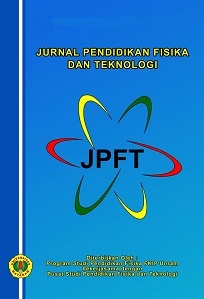Kemampuan Pemecahan Masalah dan Kreativitas Peserta Didik dengan Pendekatan Berpikir Kausalitik Berscaffolding
DOI:
10.29303/jpft.v6i1.1771Published:
2020-04-24Issue:
Vol. 6 No. 1 (2020): Januari-JuniKeywords:
problem-solving, creativity, causalitic-tinking, approach, physics learningArticles
Downloads
How to Cite
Downloads
Metrics
Abstract
This research aimed to investigate problem-solving ability (PSA) and creativity of students through physics learning with causalitic-thinking approach with scaffolding of type 2b. With the scaffolding, in learning, students have to determine all causes and predict all possible effects in a phenomenon, also give arguments how conditions of each cause so that each effect occur. However, the number of the causes and effects is informed and part of the causes, effects, and arguments also be given so the students only need to complete them. This research used method of experiment with control group design. As population were students of class XI MIA SMAN 3 Mataram year 2017/2018 while as sample were the students of class XI MIA 8 and XI MIA 9. Data of the PSA and creativity were taken by using one set of test instrument and respectively analyzed with t-test and U-test at significance level of 5%. The former test showed that tcounted is 12.621 with ttable of 2.004 which meant that the approach affected PSA of students. While, the latter one showed that zcounted is 6.69 with ztable of 1.96 which meant that the approach also affected creativity of students.References
Deta, U., Suparmi, & Widha, S. (2013). Pengaruh Metode Inkuiri Terbimbing dan Proyek, Kreativitas, Serta Keterampilan Proses Sains Terhadap Prestasi Belajar Siswa. Jurnal Pendidikan Fisika Indonesia, 9(1) , 28-34. https://doi.org/10.15294/jpfi.v9i1.2577
Hakim, A., Liliasari, Setiawan, A., & Saptawati, G. A. (2017). Interactive Multimedia Thermodynamics to Improve Creative Thinking Skill of Physics Prospective Teachers. Jurnal Pendidikan Fisika Indonesia, 13(1) , 33-40. https://doi.org/10.15294/jpfi.v13i1.8447
Helmi, F., Rokhmat, J., & 'Ardhuha, J. (2017). Pengaruh Pendekatan Berpikir Kausalitik Ber-Scaffolding Tipe 2b Termodifikasi Berbantuan LKS terhadap Kemampuan Pemecahan Masalah Fluida Dinamis Siswa. Jurnal Pendidikan Fisika dan Teknolog, 3(1) , 68-75. http://dx.doi.org/10.29303/jpft.v3i1.332
Rokhmat, J. (2013). Kemampuan Proses Berpikir Kausalitas dan Berpikir Analitik Mahasiswa Calon Guru Fisika. Jurnal Pengajaran MIPA, 18(1), 18-85. http://dx.doi.org/10.18269/jpmipa.v18i1.260
Rokhmat, J. (2015). Penerapan Pendekatan Berpikir Kausalitik Ber-scaffolding dalam Meningkatkan Kemampuan Pemecahan Masalah Hukum Newton Tentang Gerak. Prosiding Seminar Nasional Fisika . https://www.researchgate.net/publication/324274507_penerapan_pendekatan_berpikir_kausalitik_ber-scaffolding_dalam_meningkatkan_kpm_hukum_newton_tentang_gerak
Rokhmat, J., Rusdiana, D., & Setiawan, A. (2012). Pembelajaran Fisika Berbasis Proses Berpikir Kausalitas Dan Berpikir Analitik (PBK-BA), Suatu Pembiasaan Berpikir Secara Terbuka. Seminar Nasional IX Pendidikan Biologi FKIP UNS. https://jurnal.uns.ac.id/prosbi/article/view/7524/6692
Tamami, F., Rokhmat, J., & Gunada, I. W. (2017). Pengaruh Pendekatan Berpikir Kausalitik Scaffolding Tipe 2a Modifikasi Berbantuan LKS terhadap Kemampuan Pemecahan Masalah Optik Geometri dan Kreativitas Siswa Kelas XI SMAN 1 Mataram. Jurnal Pendidikan Fisika dan Teknologi, 3(1), 76-83. http://dx.doi.org/10.29303/jpft.v3i1.333.
Author Biographies
Faisal Faisal, Pendidikan Fisika, Universitas Mataram
Joni Rokhmat, Pendidikan Fisika, Universitas Mataram
Jannatin Ardhuha, Pendidikan Fisika, Universitas Mataram
License
Authors who publish with Jurnal Pendidikan Fisika dan Teknologi (JPFT) agree to the following terms:
- Authors retain copyright and grant the journal right of first publication with the work simultaneously licensed under a Creative Commons Attribution License 4.0 International License (CC-BY-SA License). This license allows authors to use all articles, data sets, graphics, and appendices in data mining applications, search engines, web sites, blogs, and other platforms by providing an appropriate reference. The journal allows the author(s) to hold the copyright without restrictions and will retain publishing rights without restrictions.
- Authors are able to enter into separate, additional contractual arrangements for the non-exclusive distribution of the journal's published version of the work (e.g., post it to an institutional repository or publish it in a book), with an acknowledgement of its initial publication in Jurnal Pendidikan Fisika dan Teknologi (JPFT).
- Authors are permitted and encouraged to post their work online (e.g., in institutional repositories or on their website) prior to and during the submission process, as it can lead to productive exchanges, as well as earlier and greater citation of published work (See The Effect of Open Access).











